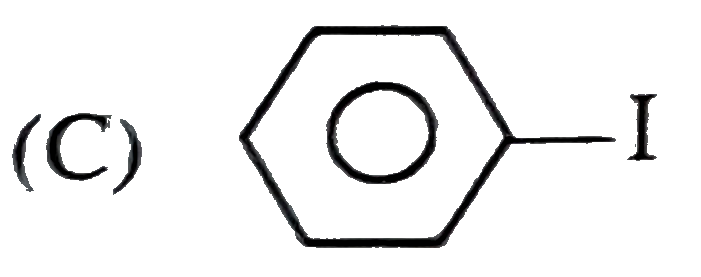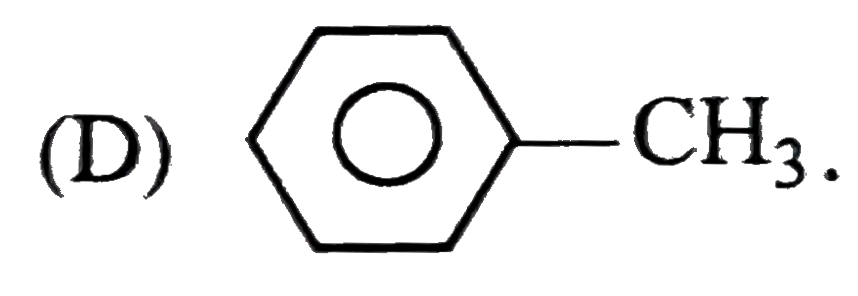C5H11Br+NaCN→AH3O+−−−→B+NaOHCaO−−→C
C' has the formula C5H12 which can give four structural isomeric monochloro derivative . What is the structure of C5H11Br ?
CH3−CH∣CH3−CH2CH2−Br
CH3−CH2−Br∣CH−CH2−CH5
CH5−CH2−CH2−CH∣Br−CH3
CH2−CH3∣C∣CH3−CH2−Br
The correct Answer is:A
To solve the question regarding the structure of C5H11Br, we will follow a systematic approach based on the information provided.
Step 1: Determine the Degree of Unsaturation (DB)
The degree of unsaturation (DB) can be calculated using the formula:
DB=C+1−H−N+X2
Where:
- C = number of carbon atoms
- H = number of hydrogen atoms
- N = number of nitrogen atoms
- X = number of halogen atoms
For C5H11Br:
- C=5
- H=11
- N=0
- X=1 (since we have one bromine atom)
Substituting the values:
DB=5+1−11−0+12=−42=0
This indicates that there are no pi bonds or rings in the structure, suggesting it is either a straight-chain or branched alkyl halide.
Hint: The degree of unsaturation helps identify if there are rings or double bonds in the molecule.
Step 2: Reaction with Sodium Cyanide (NaCN)
The reaction of C5H11Br with NaCN will replace the bromine atom with a cyanide group:
C5H11Br+NaCN→C5H11CN
This results in the formation of a nitrile compound.
Hint: The nucleophilic substitution reaction replaces the halogen with a cyanide group.
Step 3: Hydrolysis of the Nitrile
Hydrolysis of the nitrile C5H11CN in the presence of H3O+ will convert the nitrile into a carboxylic acid:
C5H11CN+H3O+→C5H11COOH
This step involves breaking the carbon-nitrogen triple bond and forming a carboxylic acid.
Hint: Hydrolysis of nitriles typically yields carboxylic acids.
Step 4: Decarboxylation
When the carboxylic acid C5H11COOH is treated with NaOH and heated with CaO, decarboxylation occurs, leading to the formation of an alkene:
C5H11COOHNaOH,CaO−−−−−−−→C5H12+CO2
This results in the formation of an alkene with the formula C5H12.
Hint: Decarboxylation reactions remove carbon dioxide and often yield alkenes.
Step 5: Identify the Structure of C5H12
The final compound C5H12 can form four structural isomeric monochloro derivatives. This indicates that the structure must have sufficient branching to allow for different positions of the chlorine atom.
The possible structure of C5H11Br that can lead to four isomeric monochloro derivatives is:
- 2-Bromopentane: This structure allows for chlorination at four different carbon positions.
Hint: The ability to form multiple isomers indicates that the compound has a branched structure.
Conclusion
The structure of C5H11Br is likely 2-Bromopentane, which can yield four structural isomers upon chlorination.
The degree of unsaturation (DB) can be calculated using the formula:
DB=C+1−H−N+X2
Where:
- C = number of carbon atoms
- H = number of hydrogen atoms
- N = number of nitrogen atoms
- X = number of halogen atoms
- C=5
- H=11
- N=0
- X=1 (since we have one bromine atom)
DB=5+1−11−0+12=−42=0
This indicates that there are no pi bonds or rings in the structure, suggesting it is either a straight-chain or branched alkyl halide.
The reaction of C5H11Br with NaCN will replace the bromine atom with a cyanide group:
C5H11Br+NaCN→C5H11CN
This results in the formation of a nitrile compound.
Hydrolysis of the nitrile C5H11CN in the presence of H3O+ will convert the nitrile into a carboxylic acid:
C5H11CN+H3O+→C5H11COOH
This step involves breaking the carbon-nitrogen triple bond and forming a carboxylic acid.
When the carboxylic acid C5H11COOH is treated with NaOH and heated with CaO, decarboxylation occurs, leading to the formation of an alkene:
C5H11COOHNaOH,CaO−−−−−−−→C5H12+CO2
This results in the formation of an alkene with the formula C5H12.
The final compound C5H12 can form four structural isomeric monochloro derivatives. This indicates that the structure must have sufficient branching to allow for different positions of the chlorine atom.
- 2-Bromopentane: This structure allows for chlorination at four different carbon positions.
The structure of C5H11Br is likely 2-Bromopentane, which can yield four structural isomers upon chlorination.
Topper's Solved these Questions
- HALOALKANES AND HALOARENES BOOK - AAKASH INSTITUTECHAPTER - HALOALKANES AND HALOARENES EXERCISE - ASSIGNMENT SECTION -D
15 Videos
- HALOALKANES AND HALOARENES BOOK - AAKASH INSTITUTECHAPTER - HALOALKANES AND HALOARENES EXERCISE - ASSIGNMENT SECTION - B
25 Videos
- GENERAL PRINCIPLES AND PROCESSES OF ISOLATION OF ELEMENTSBOOK - AAKASH INSTITUTECHAPTER - GENERAL PRINCIPLES AND PROCESSES OF ISOLATION OF ELEMENTSEXERCISE - Try Yourself
33 Videos
- HYDROCARBONSBOOK - AAKASH INSTITUTECHAPTER - HYDROCARBONSEXERCISE - Assignment(Section - D) (Assertion -Reason Type Question)
24 Videos
Similar Questions
Knowledge Check
C2H5BrAgCN−−−→PH3O+−−−→HCOOH+Q, Q is
ACH3−CH2CONH2BCH3−CH2−C≡NCCH3−CH2−NH2DCH3−COOHC6H5CHONH2OH−−−−→ A H2O−−→ B
What is not true for the compound B –AGives cannizaro’s reactionBActs as strong reducing agentCGives phenol on reductionDGives optical active compound with HCNC6H5BrMg−−→XCH3I−−→Y
The product Y isA B
B C
C D
D
How many structural isomers are possible for the molecular formula C5H11Br?
View SolutionC2H4Br2−−→XKCN−−→Y,Y is
View SolutionC2H5BrAgCN−−−→PH3O+−−−→HCOOH+Q Q is:
View SolutionC2H5NH2HNO2−−−→APCl3−−→BNH3−−→C
Recognise the compound C from the following
View SolutionC5H10H2/Ni−−−→(X)Cl2/hv−−−→3 monochloro structural isomers for compound C5H10 how many pairs of geometrical isomers are possible
View Solution
